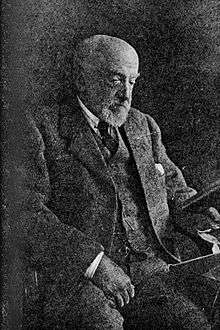Dukinfield Henry Scott
Dr Dukinfield Henry Scott FRS[1] HFRSE LLD (28 November 1854 – 29 January 1934) was a British botanist. The standard author abbreviation D.H.Scott is used to indicate this person as the author when citing a botanical name.[2]
Dukinfield Henry Scott | |
|---|---|
 D. H. Scott | |
| Born | 28 November 1854 |
| Died | 29 January 1934 (aged 79) |
| Nationality | British |
| Alma mater | Oxford University Würzburg University |
| Scientific career | |
| Fields | Botany |
| Institutions | University College, London Royal College of Science Royal Gardens at Kew |
| Doctoral advisor | Julius von Sachs |
| Author abbrev. (botany) | D.H.Scott |
Life
Scott was born in London on 28 November 1854, the fifth and youngest son of architect Sir George Gilbert Scott[3] and his wife Caroline Oldrid. One consequence was that he was of independent financial means and was not affiliated with an academic institution for much of his life.[4]
Scott studied Natural Sciences at Oxford University, graduating with his M.A., and then went on as a postgraduate at Würzburg University in Germany. There, he studied under the famous botanist Julius von Sachs, and earned his doctorate.
From 1882 to 1885, he was Assistant to the Professor of Botany at University College, London, and from 1885 to 1892, Assistant Professor in Biology (Botany) at the Royal College of Science, South Kensington. In 1892, Scott left the Royal College of Science when he was appointed Honorary Keeper of the Jodrell Laboratory, Royal Gardens at Kew, a position he held for fourteen years.[5] He published many papers on botany in scientific journals. He did important work in paleobotany as the younger colleague of William Crawford Williamson, one of the founders of paleobotany.[6] He made use of the assistance of his wife to provide illustrations and indexes for his publications as well as to catalogue his collection of fossil slides. He supported the education of women and was the first lecturer in botany at University College who allowed women to attend his classes.[4]
He was President of the Royal Microscopical Society from 1904 to 1906.[7] He was president of the Linnean Society from 1908 to 1912. He was elected a member of the Royal Swedish Academy of Sciences in 1916 and a Fellow of the Royal Society in June 1894.[8] In 1930 he was elected an Honorary Fellow of the Royal Society of Edinburgh.[9]
He was awarded the Royal Medal of the Royal Society in 1906, the Linnean Medal of the Linnean Society in 1921, the Darwin Medal of the Royal Society in 1926 and the Wollaston Medal of the Geological Society of London in 1928.[1]
He moved with his family to East Oakley House near Basingstoke, in Hampshire in 1906. He continued to research and publish from there until his death.
Family
In 1887 he married Henderina Victoria Klaassen (d.1929). They had seven children, one of whom died in infancy.
One of his most brilliant students was Harold Wager, who became his student in botany in 1886 and went on to become a Fellow of the Royal Society of London in 1904.
Selected publications
- Scott, Dukinfield Henry (1894, 1896.) An Introduction to Structural Biology. (2 volumes).
- Scott, Dukinfield Henry (1900). Studies in Fossil Botany. A. and C. Black.
- Scott, Dukinfield Henry (1911). The Evolution of Plants. H. Holt and Co.
References
- o., F. W.; s., A. C. (1934). "Dukinfield Henry Scott. 1854-1934". Obituary Notices of Fellows of the Royal Society. 1 (3): 205. doi:10.1098/rsbm.1934.0006. JSTOR 768823.
- IPNI. D.H.Scott.
- Arber, Agnes; Goldbloom, Alexander. "Scott, Dukinfield Henry". Oxford Dictionary of National Biography (online ed.). Oxford University Press. doi:10.1093/ref:odnb/35984. (Subscription or UK public library membership required.)
- Jones, Claire G (2016). The tensions of homemade science in the work of Henderina Scott and Hertha Ayrton. Springer. pp. 84–104.
- Addison, Henry Robert; Oakes, Charles Henry; Lawson, William John; Sladen, Douglas Brooke Wheelton (1907). "SCOTT, Dukinfield Henry". Who's Who. Vol. 59. p. 1571.
- Oliver, F. W. (1934). "Dukinfield Henry Scott 1854-1934". New Phytologist. 33 (2): 73. doi:10.1111/j.1469-8137.1934.tb06800.x.
- Biographical Index of Former Fellows of the Royal Society of Edinburgh 1783–2002 (PDF). The Royal Society of Edinburgh. July 2006. ISBN 0 902 198 84 X.
- "Library and Archive catalogue". The Royal Society. Retrieved 12 October 2010.
- Biographical Index of Former Fellows of the Royal Society of Edinburgh 1783–2002 (PDF). The Royal Society of Edinburgh. July 2006. ISBN 0 902 198 84 X.
External links
![]()